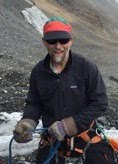Well. Today we got up bright and early, got organized, and packed up ready to head out to the Kongsvagen. We got all our gear together fairly quickly, and were ready to go. The weather was warm, not a good sign, and it was drizzling rain, which made things even worse. This was a big change for me, since I'm used to working high on polar ice sheets, where rain is almost unheard of and the snow never gets wet.

the team assembled, ready to head out to the Kongsvagen.
We hadn't gotten far before we came to something else new to me, namely riding a snowmachine over topography; since the weather is so warm there is no ice in the fjord this year, we needed to traverse overland to get to the Kongsvagen, which involves going over a few fairly steep passes. As I had a heavy load to haul (geophysicists always seem to have heavy equipment), I had a big brute of a snowmachine, with an engine bigger than the one on my first car! Starting it up, it sounded more like a harley-davidson than a snowmobile. Fortunately with all that power I was able to get up and over the passes without much difficulty.
Then came the very soft, slushy snow on the other side. In order to stay on top of it and not sink in, it's important to keep driving very fast. We charged on, until we came to a wide section full of very watery, slushy snow. The lead snow machine was able to make it thorugh, but only with difficulty, and it was a very powerful machine with a very experienced driver. It didn't look very good for the less powerful machines and heavier loads. In addition, with the weather as it was, this section might well be impassible in the evening when we were heading back. It was time to regroup and decide what to do.

The team discusses the options.
We decided to head back to Ny-Alesund and hope for cooler, better weather tomorrow. 4 of the team would try in the afternoon to get over to the glacier for some mass balance measurements, not carrying heavy loads and taking a different route.
But it was not to be. On the way home we found that the snow had gotten softer at the steepest pass, causing trouble. We were able to use the powerful machines to bring the sleds over the pass, after a couple of failed attempts with the smaller snowmachines. But the least powerful machine of all just didn't seem capable of climbing the steep slope. Again and again we tried, but in the end it was decided that that machine would have to be ferried around on a much longer route, with fewer steep slopes. The plan for trying to take a lighter party of 4 to the glacier was cancelled, and the rest of us continued on home, to plan for tomorrow.













